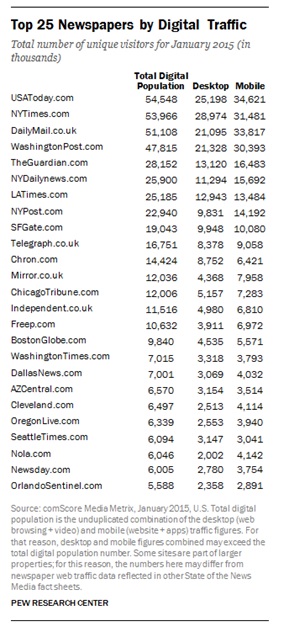Pew’s recently released State of the News Media report finds that 39 of the top 50 digital news websites receive more traffic from mobile devices than from desktop computers. A mobile majority now exists amongst the news entities looked at in this study, including legacy print, cable, network, international and public broadcasting outlets as well as digital-only entities. For half of these top 50 news sites, desktop users stay longer than mobile users. Only twenty percent of sites received more traffic from desktops when compared with mobile. The annual report contains a wealth of information on the rapidly diversifying news industry. Here we highlight relevant findings about the growth of digital news.
Top 25 Newspapers by Digital Traffic

Source: Pew Research Center
The social Web continues to rise alongside mobile growth
Pew has found that nearly half of adults who use the Web found news about politics and government in the past week on Facebook. As Pew notes, the news shown on a social media platform like Facebook is strongly influenced by friends and the newsfeed algorithm. These and other findings have important ramifications for the relationship between information and democracy. Josh Bleiberg and Darrell West recently wrote about how Millennials consume the news, citing that Facebook is the main social network for this group’s news consumption.
The ups and downs of the broadcast media landscape
While local and network television news experienced slight upticks in broadcast viewers, cable news had another rough year, with prime-time median viewership down 8 percent across Fox News, MSNBC, and CNN. One promising area of growth is digital and mobile developments for audio broadcasting. Podcast listening is increasing, with NPR’s podcast downloads alone growing 41 percent year over year. The implications of podcasting for news delivery remain unclear at this point.
Digital ads are not a panacea for the news industry
For legacy news sources like newspapers, local and network TV, significant digital revenues remain largely elusive. “None get more than a small share of their total revenue from digital, even though digital ad revenue across all media grew 18% in 2014 to $50.7 billion, according to eMarketer. Mobile ad spending alone increased 78%, though that is a slowdown from the two years prior.” Relationships have formed between news organizations and tech companies, though the latter still reap most of the financial benefit. In fact, five companies (Google, Facebook, Microsoft, Yahoo and AOL) generated 61 percent of total domestic digital ad revenue in 2014, $30.9 billion out of a total $50.7 billion. Yet their combined share has decreased about 1 percentage point each year since 2010.
Digital-only news faces similar challenges that legacy news organizations face
Financial and journalistic challenges are still present for enterprises with a digital-first approach, and the fluctuations present in the broadcast industry are reflected here too. For instance, tech journalism site Gigaom shut down on March 9, 2015, unable to pay its creditors. BuzzFeed built up its investigative and foreign teams but still faced ethical questions about deleting posts due to advertising pressure. One of the main takeaways from a tumultuous, yet still promising, year for many news organizations with reorganizations and new entrants is Pew’s observation: “There is no organized method as yet for tracking the growing digital-only segment of the news media.” The better the new news landscape can be understood, the closer we can come to assessing whether it is working for or against America’s democracy.


Commentary
Mobile Majority: State of the News Media 2015
May 6, 2015